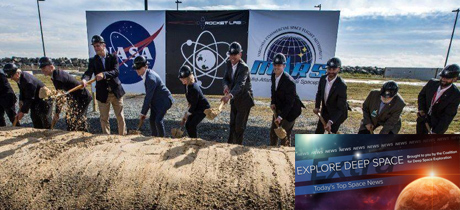In Today’s Deep Space Extra… James Morhard has been sworn in as NASA’s deputy administrator. Astronomers express concern for the future of space observatories. Rocket Lab picks NASA’s Wallops Island Flight Facility for U.S. launch site.
Human Space Exploration
Morhard sworn in as deputy administrator
Spacepolicyonline.com (10/17): James Morhard, a longtime U.S. congressional staffer, was sworn in Wednesday as NASA’s deputy administrator. His White House nomination was confirmed by the U.S. Senate on October 11.
Space Science
As NASA’s prized telescopes falter, astronomers fear losing their eyes in space
Washington Post (10/18): Recent difficulties with the Hubble Space Telescope, now 28, and the Chandra X-ray telescope, now 19, have the community of astronomers concerned that budget and technical concerns may slow efforts to replace NASA’s aging Great Observatories with new generations of space telescopes. The launch of the James Webb Space Telescope (JWST), Hubble’s designated successor, was recently delayed until March 2021 by pre-launch cost and technical concerns. The White House seeks cancellation of the Wide Field Infrared Survey Satellite (WFIRST) in its 2019 budget proposal for NASA, citing cost and technical challenges. “We’re facing a very daunting prospect as a community,” Matt Mountain, president of the Association of Universities for Research in Astronomy, told the Post. “Some fields just won’t have a telescope. And the science will not be possible to do in any other way.”
NASA’s planet-hunting space telescope nears its end
Science (10/17): After a productive mission discovering extra solar planets, NASA’ Kepler space telescope is running out of fuel and the nine year endeavor will soon come to an end. Kepler has overcome multiple reaction wheel failures to log 2,650 confirmed extra solar planet discoveries and nearly 3,000 additional prospects awaiting confirmation. The bounty includes 30 rocky planets less than twice the size of the Earth. Based on Kepler’s bounty, astronomers estimate the Milky Way Galaxy is home to 100 billion planets. Launched earlier this year, NASA’s Transiting Exoplanet Survey Satellite, or TESS, is continuing the exo-planet search with a focus on the nearest stars.
Universe Today (10/17): Fast Radio Bursts have puzzled astronomers since they were discovered in 2007. Focusing quickly on the transient phenomena, Australian radio astronomers have raced to identify the most sources of the powerful outbursts, whose origins are not clear.
In first for a spacecraft, Parker Solar Probe autonomously manages heat load on solar arrays
NASA/Goddard (10/17): Launched August 12, NASA’s Solar Parker Probe is on an aggressive mission to study the sun closer than ever before. Earlier this week the spacecraft received its first gravity assist from Venus. As it nears the sun and the temperatures climb, Parker is adjusting by autonomously shielding its crucial solar arrays from what will be searing heat.
NASA’s Fermi mission energizes the sky with gamma-ray constellations
Physics.org (10/17): Now more than 10 years in orbit, NASA’s Fermi Gamma-ray space telescope has broken new ground among the star constellation community. Once the province of stars visible to the human eye in the night sky, star constellations may now be comprised of not so visible celestial gamma ray sources — thanks to Fermi. “Developing these unofficial constellations was a fun way to highlight a decade of Fermi’s accomplishments,” said Julie McEnery, the Fermi project scientist at NASA’s Goddard Space Flight Center. Gamma ray constellation names include The Little Prince and The Hulk.
Other News
ULA CEO Bruno: New competitors in military launch market ‘good for the country’
Coalition Member in the News – United Launch Alliance
SpaceNews.com (10/17): On the heels of Wednesday’s successful launch of a U.S. Air Force communications satellite aboard a United Launch Alliance (ULA) Atlas 5 from Cape Canaveral Air Force Station, Florida, ULA president and CEO Tory Bruno says he welcomes the competition emerging in the U.S. commercial launch market as much as the military welcomes the flexibility to choose among launch vehicles. “One of the ways you get flexibility when you have uncertainty is to make sure you can still go to every single orbit, go there with all the mass you can take, and maybe ask for a little bit more,” said Bruno.
Rocket Lab reveals new factory and launch site, aims for 16 flights next year
Ars Technica (10/17): Rocket Lab, the small rocket start up, announced Wednesday that it plans to establish a fast paced, U.S. launch capability at the Mid-Atlantic Regional Spaceport located at NASA’s Wallops Island Flight Facility on Virginia’s eastern shore. Though based in the U.S., Rocket Lab has focused much of its start up plans in New Zealand. Mid-Atlantic offered the best U.S. location for rapid launch facility development, according to company CEO Peter Beck.

